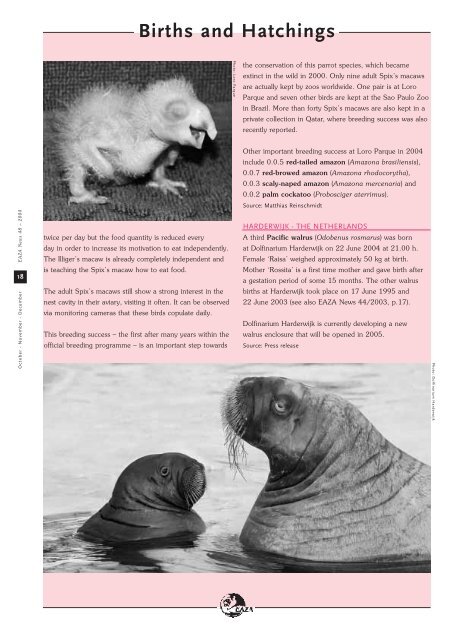EAZA NEWS 48 - European Association of Zoos and Aquaria
EAZA NEWS 48 - European Association of Zoos and Aquaria
EAZA NEWS 48 - European Association of Zoos and Aquaria
You also want an ePaper? Increase the reach of your titles
YUMPU automatically turns print PDFs into web optimized ePapers that Google loves.
<strong>EAZA</strong> News <strong>48</strong> – 2004<br />
18<br />
October - November - December<br />
twice per day but the food quantity is reduced every<br />
day in order to increase its motivation to eat independently.<br />
The Illiger’s macaw is already completely independent <strong>and</strong><br />
is teaching the Spix’s macaw how to eat food.<br />
The adult Spix’s macaws still show a strong interest in the<br />
nest cavity in their aviary, visiting it <strong>of</strong>ten. It can be observed<br />
via monitoring cameras that these birds copulate daily.<br />
This breeding success – the first after many years within the<br />
<strong>of</strong>ficial breeding programme – is an important step towards<br />
Births <strong>and</strong> Hatchings<br />
Photo: Loro Parque<br />
the conservation <strong>of</strong> this parrot species, which became<br />
extinct in the wild in 2000. Only nine adult Spix’s macaws<br />
are actually kept by zoos worldwide. One pair is at Loro<br />
Parque <strong>and</strong> seven other birds are kept at the Sao Paulo Zoo<br />
in Brazil. More than forty Spix’s macaws are also kept in a<br />
private collection in Qatar, where breeding success was also<br />
recently reported.<br />
Other important breeding success at Loro Parque in 2004<br />
include 0.0.5 red-tailed amazon (Amazona brasiliensis),<br />
0.0.7 red-browed amazon (Amazona rhodocorytha),<br />
0.0.3 scaly-naped amazon (Amazona mercenaria) <strong>and</strong><br />
0.0.2 palm cockatoo (Probosciger aterrimus).<br />
Source: Matthias Reinschmidt<br />
HARDERWIJK - THE NETHERLANDS<br />
A third Pacific walrus (Odobenus rosmarus) was born<br />
at Dolfinarium Harderwijk on 22 June 2004 at 21.00 h.<br />
Female ‘Raisa’ weighed approximately 50 kg at birth.<br />
Mother ‘Rossita’ is a first time mother <strong>and</strong> gave birth after<br />
a gestation period <strong>of</strong> some 15 months. The other walrus<br />
births at Harderwijk took place on 17 June 1995 <strong>and</strong><br />
22 June 2003 (see also <strong>EAZA</strong> News 44/2003, p.17).<br />
Dolfinarium Harderwijk is currently developing a new<br />
walrus enclosure that will be opened in 2005.<br />
Source: Press release<br />
Photo: Dolfinarium Harderwijk
















